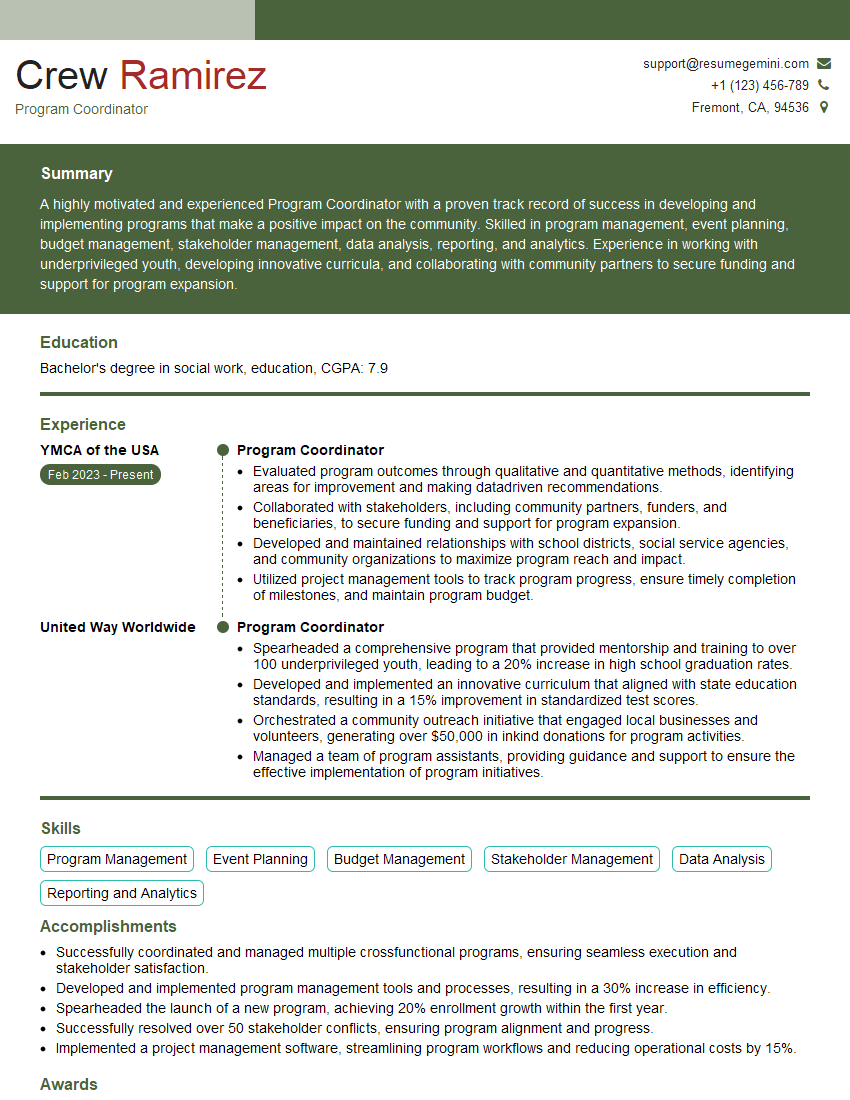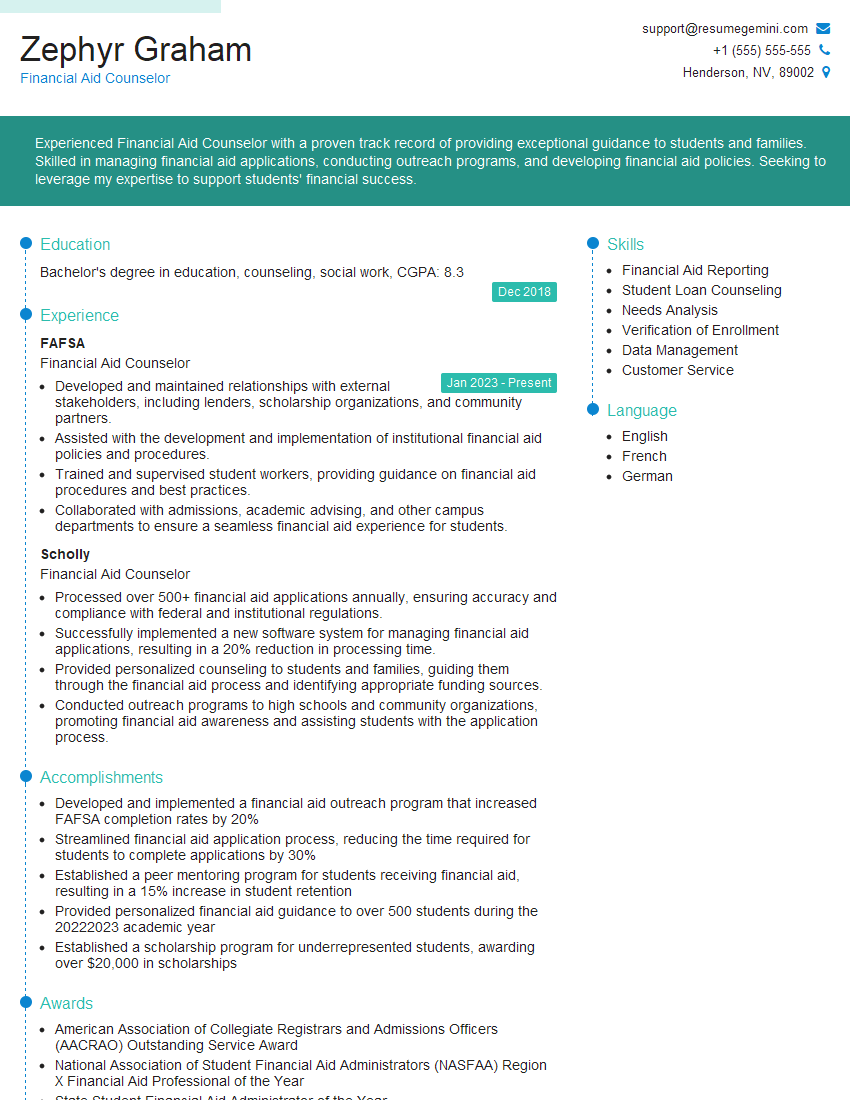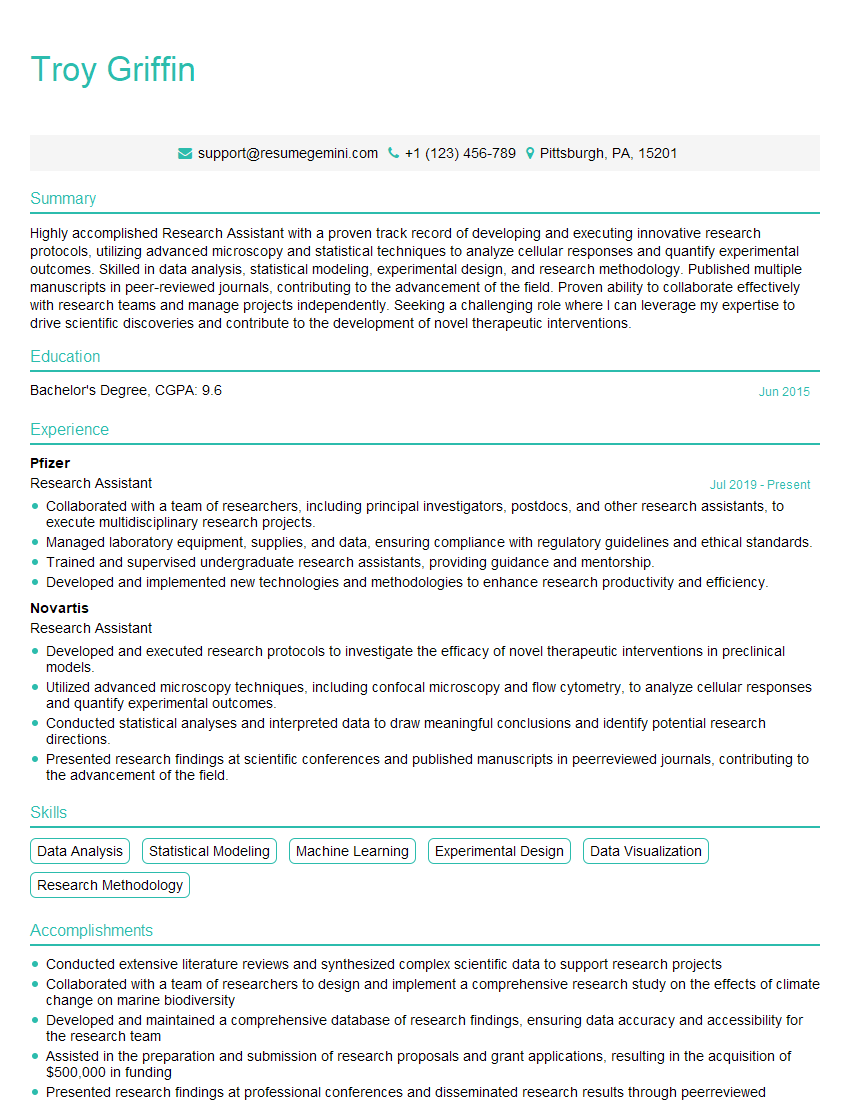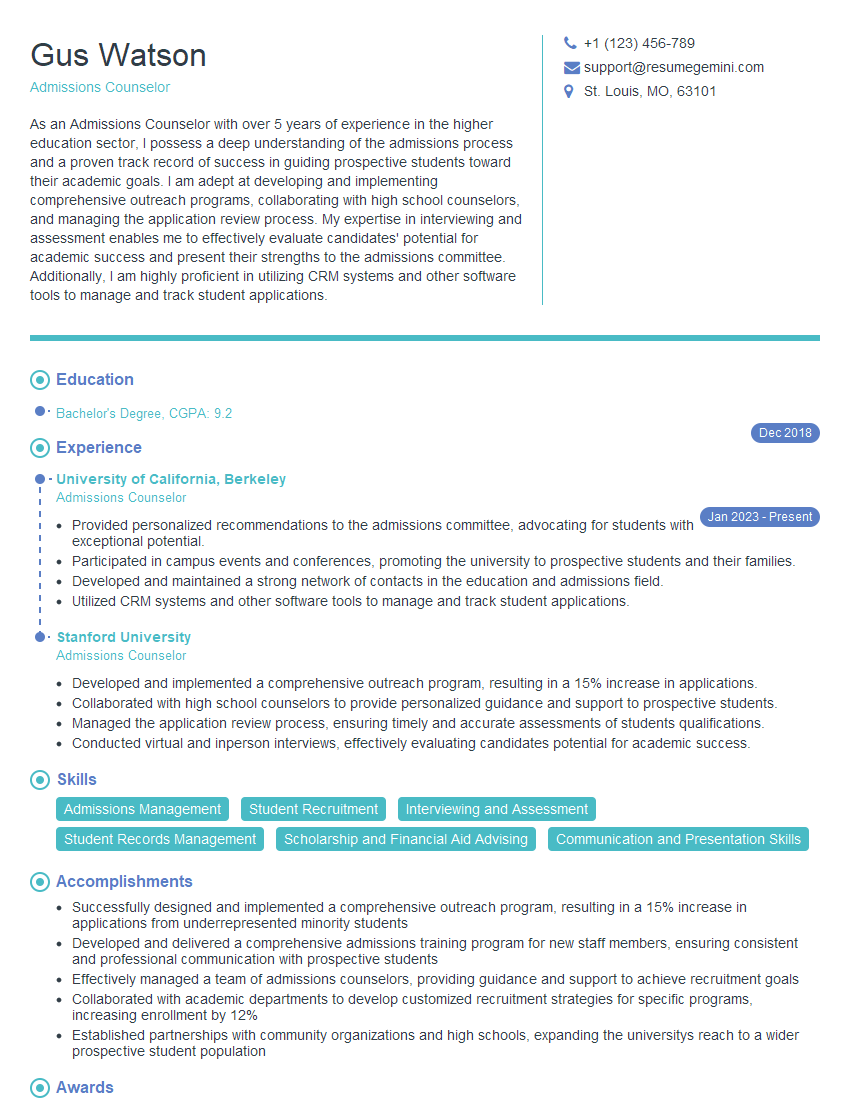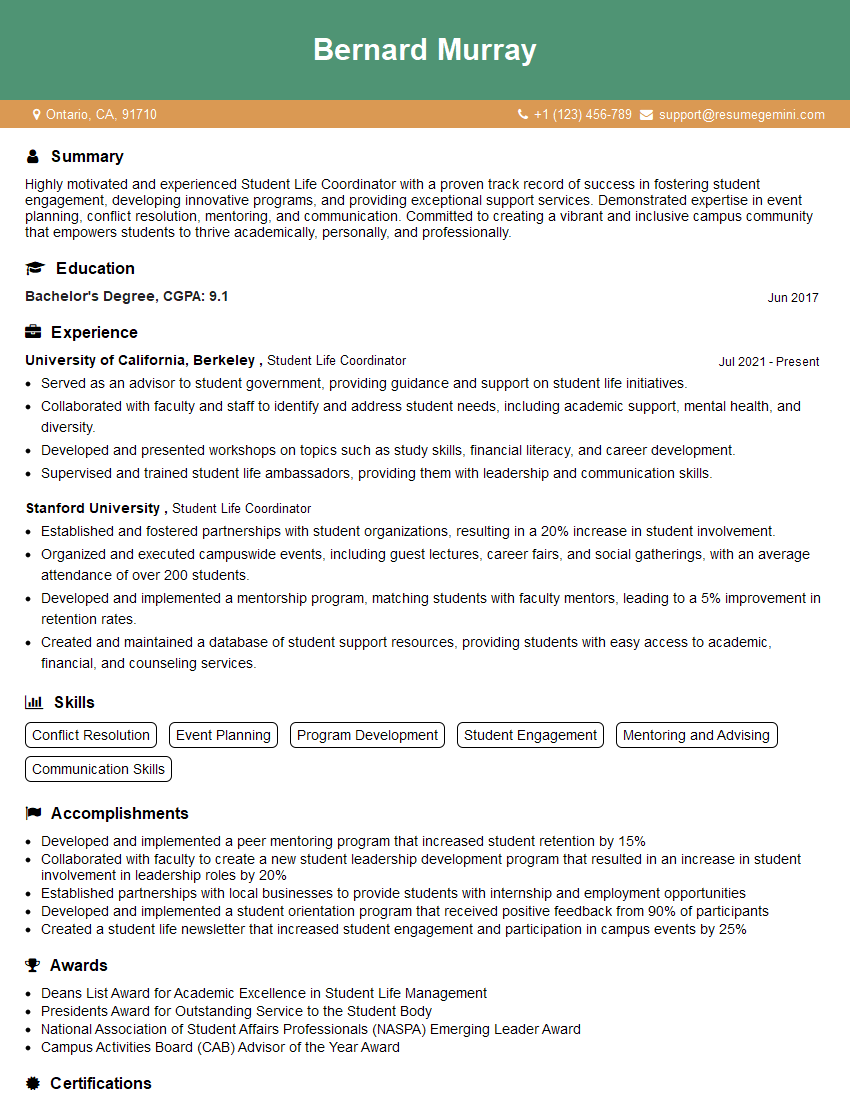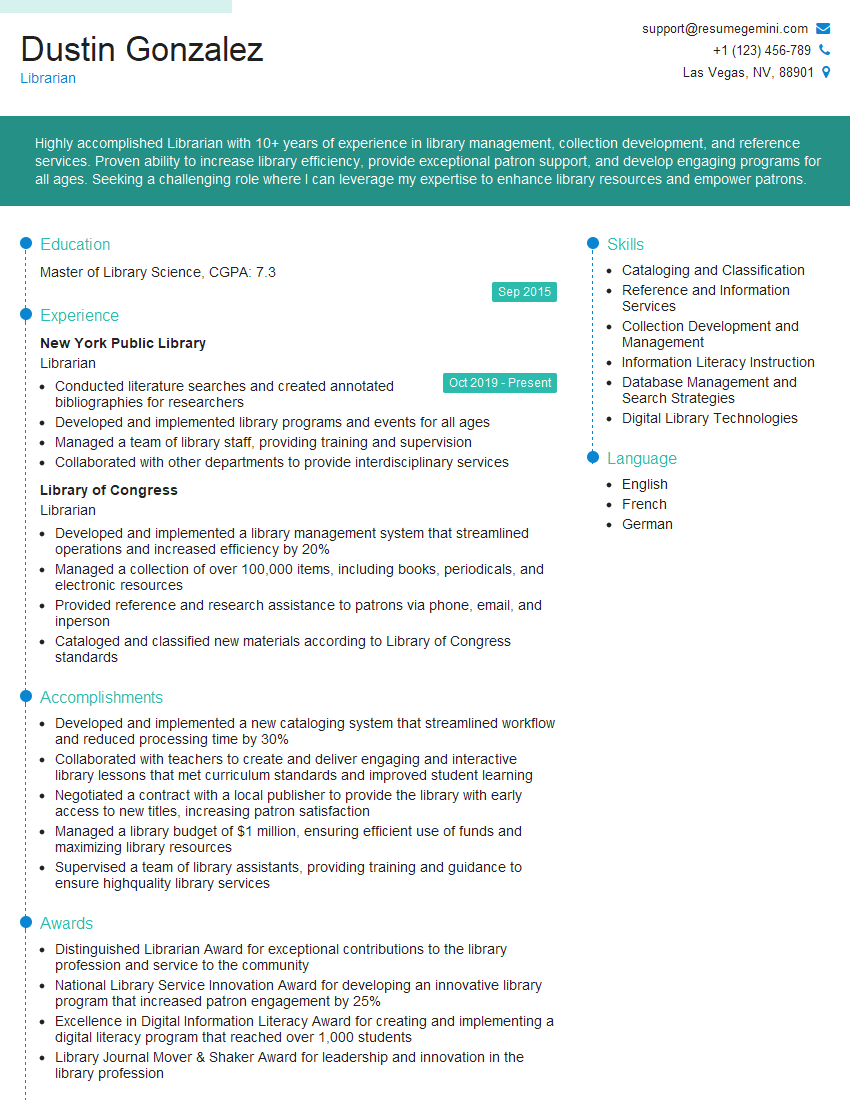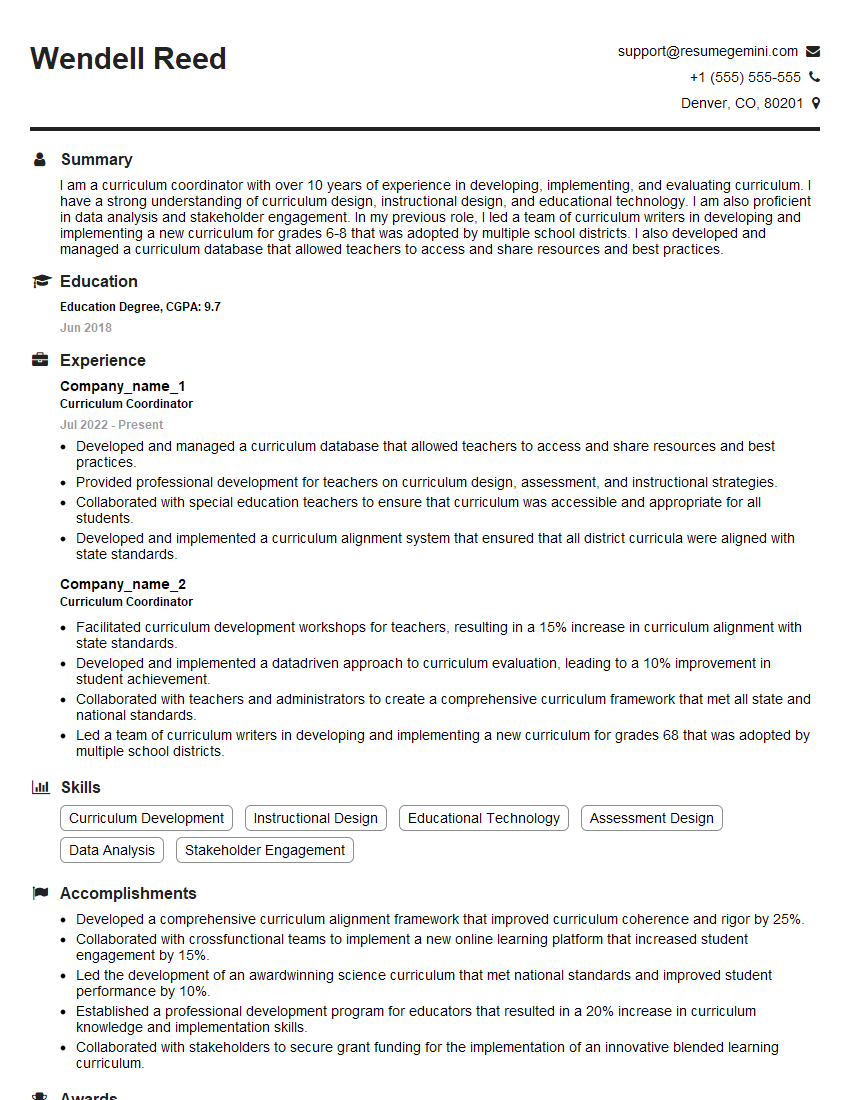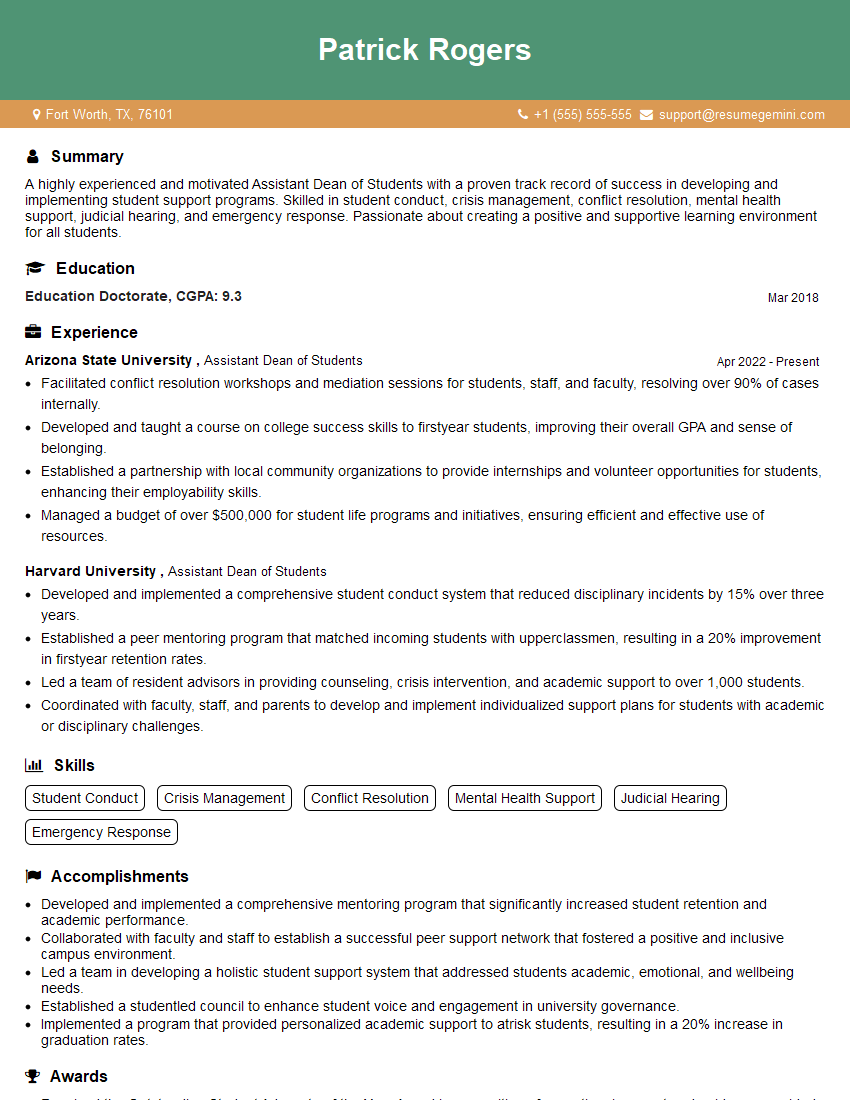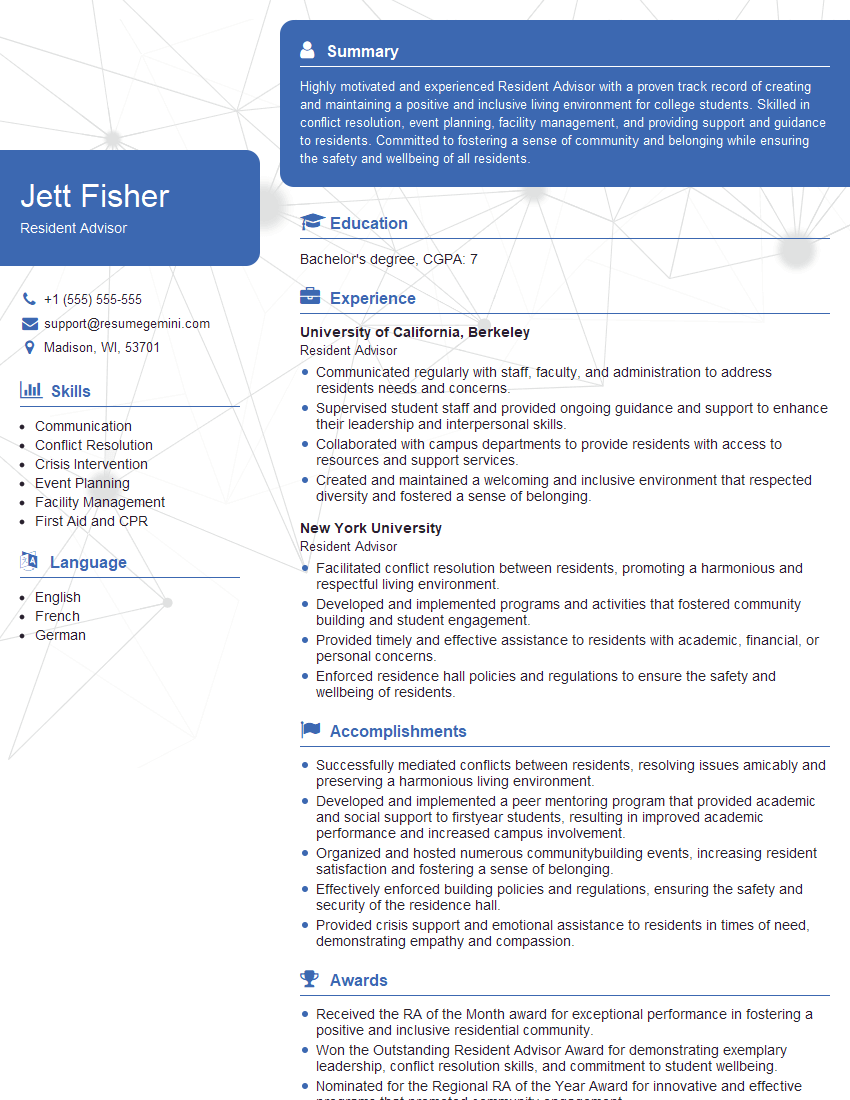Cracking a skill-specific interview, like one for Ability to work effectively with faculty, staff, and students, requires understanding the nuances of the role. In this blog, we present the questions you’re most likely to encounter, along with insights into how to answer them effectively. Let’s ensure you’re ready to make a strong impression.
Questions Asked in Ability to work effectively with faculty, staff, and students Interview
Q 1. Describe your experience resolving conflicts between faculty and students.
Resolving conflicts between faculty and students requires a delicate balance of empathy, fairness, and effective communication. My approach centers on active listening to understand each perspective fully, identifying the root cause of the disagreement, and collaboratively finding a solution that respects everyone’s concerns.
For example, I once mediated a dispute between a professor and a student regarding a grade. Instead of immediately judging, I separately spoke with both individuals to understand their viewpoints. The professor felt the student hadn’t met the assignment’s criteria, while the student felt the rubric was unclear. By facilitating a conversation where both parties could express their concerns, we discovered a misunderstanding about the grading criteria. We collaboratively clarified the rubric and agreed on a fair revised grade based on the updated understanding. The key was creating a safe space for open dialogue and focusing on finding a mutually acceptable solution, not assigning blame.
Q 2. How do you foster a collaborative environment in a team setting with diverse personalities?
Fostering a collaborative environment with diverse personalities requires recognizing and valuing individual strengths while establishing clear communication channels and shared goals. I find it essential to build trust through active listening and mutual respect. This involves actively seeking out each team member’s input, acknowledging their contributions, and creating a psychologically safe space where everyone feels comfortable sharing their ideas, even if they are different from the norm.
In a past project, our team included individuals with vastly different work styles – some preferred meticulous planning, while others thrived on improvisation. By clearly defining roles and responsibilities based on individual strengths, and regularly holding open and honest communication sessions, we successfully navigated these differences. We used a project management tool to ensure transparency and track progress, which helped everyone stay aligned and informed.
Q 3. Explain a time you had to adapt your communication style to effectively reach a specific audience (faculty, staff, or students).
Adapting my communication style is crucial for effective interaction with various audiences. When addressing faculty, I use precise language, highlighting research and evidence. With staff, I focus on efficiency and practicality, emphasizing clear instructions and timelines. For students, I prioritize clarity, empathy, and encouragement, ensuring they understand the information and feel supported.
Recently, I had to present complex budget data to both faculty and staff. For the faculty, my presentation emphasized the financial implications of research grants and potential funding opportunities. For the staff, the presentation focused on the budget’s impact on departmental operations and the allocation of resources. By tailoring my language, examples, and focus to each group’s needs, I ensured they understood the information’s relevance and importance to their respective roles.
Q 4. How do you handle situations where multiple stakeholders have conflicting priorities?
Handling conflicting priorities among stakeholders necessitates a structured approach that prioritizes open communication, compromise, and collaboration. I begin by clearly identifying all stakeholders and their respective priorities. Then, I facilitate a discussion to understand the underlying reasons for the conflict, often revealing shared goals hidden beneath surface tensions. Finally, I work with the stakeholders to create a prioritized list of actions, considering the feasibility and impact of each option, leading to a mutually agreeable solution, even if it involves compromises from all parties.
This approach is similar to using a weighted decision matrix, where each priority is assigned a weight based on its importance and feasibility. This allows for a transparent and objective evaluation of options and helps stakeholders understand the rationale behind the final decision.
Q 5. Describe your process for building rapport and trust with individuals from different backgrounds and roles.
Building rapport and trust across diverse groups relies heavily on genuine interest, active listening, and respectful communication. I start by actively seeking to understand each individual’s background, perspectives, and experiences. I make an effort to learn names and use them, show genuine interest in their work and personal lives (appropriately), and demonstrate respect for their expertise. I also ensure my communication style is inclusive and avoids language that could be perceived as exclusionary or biased. Consistent, reliable interactions further strengthen the foundation of trust.
For instance, I made a point to learn about the cultural backgrounds of international students and staff members, showing appreciation for their unique perspectives. This simple act of acknowledgment fostered a sense of belonging and mutual respect, significantly improving communication and collaboration.
Q 6. Share an example of successfully navigating a challenging group project involving faculty and students.
During a challenging capstone project, student enthusiasm waned as the complexity increased. The faculty advisor felt the project was falling behind schedule. I intervened by first holding individual meetings with each student to understand their specific concerns and roadblocks. Then, I facilitated a team meeting where the students openly discussed their challenges, and the faculty advisor clarified expectations. We collaboratively redefined the project scope, breaking down the large project into smaller, manageable tasks with clear deadlines. This involved creating a detailed project timeline with clear responsibilities and regular check-in points. The result was a more focused, efficient project, a boosted student morale, and a successful project outcome.
Q 7. How do you provide constructive feedback to faculty, staff, or students?
Providing constructive feedback involves offering specific, actionable suggestions for improvement, framed within a supportive and encouraging context. My approach emphasizes focusing on the work itself, not the individual’s inherent abilities. I start by highlighting the strengths and positive aspects of the work before addressing areas needing improvement. Feedback is always presented in a way that is specific, measurable, achievable, relevant, and time-bound (SMART), providing actionable steps for growth. The goal is to empower individuals to learn and improve, fostering a culture of continuous development.
For example, when providing feedback on a faculty member’s teaching, I would begin by praising their engaging lecture style and then suggest specific strategies for improving student participation based on observed classroom dynamics. I might also offer resources, such as links to relevant articles or workshops on innovative teaching methods. For students, this might involve providing targeted feedback on a specific assignment, highlighting areas of strength and suggesting ways to refine their approach for future submissions. The key is to remain focused on improvement and growth, never resorting to personal criticism.
Q 8. How do you ensure everyone feels heard and valued in a group discussion?
Ensuring everyone feels heard and valued in a group discussion is crucial for productive collaboration. My approach is multifaceted and focuses on creating a safe and inclusive environment where diverse perspectives are welcomed and respected.
- Establish Ground Rules: Before starting, I clearly define expectations for respectful communication, active listening, and equitable participation. This could include agreeing to avoid interrupting, taking turns speaking, and showing empathy towards different viewpoints.
- Facilitate Inclusive Participation: I actively encourage quieter members to contribute by directly addressing them with open-ended questions like, “What are your thoughts on this?” or “Can you elaborate on that point?” I also use techniques like round-robin discussions to ensure everyone gets a chance to speak.
- Active Listening and Summarization: I pay close attention to both verbal and nonverbal cues. I regularly summarize points to ensure everyone is on the same page and to confirm understanding. This shows that I’m listening and valuing their contributions.
- Respectful Disagreement: I create space for respectful disagreement. I emphasize that differing opinions are valuable and encourage constructive dialogue by reframing disagreements as opportunities for learning and growth. I might say something like, “I see we have differing perspectives, let’s explore these ideas further to find common ground.”
- Post-Discussion Feedback: After the discussion, I may informally check in with individuals to see if they felt heard and valued. This demonstrates my commitment to continuous improvement and inclusivity.
For instance, in a faculty meeting discussing curriculum changes, I successfully incorporated all suggestions by using a collaborative online whiteboard, allowing everyone to visually contribute and see the synthesis of all ideas. This fostered a sense of ownership and shared responsibility.
Q 9. Describe a time you had to mediate a disagreement between faculty members.
In a previous role, two senior faculty members clashed over the allocation of lab resources. One felt the other was unfairly prioritizing their research, leading to tension and unproductive meetings. To mediate, I first scheduled individual meetings with each faculty member to understand their perspectives and concerns empathetically. I focused on active listening, ensuring they felt heard and understood without judgment. Then, I facilitated a joint meeting where I established a structured approach.
- Neutral Ground: I chose a neutral location to minimize bias and encourage a more open dialogue.
- Reframing the Issue: Instead of focusing on blame, I reframed the issue as a resource allocation problem requiring a collaborative solution.
- Collaborative Problem-Solving: I guided them through a brainstorming session, encouraging them to identify potential solutions together. We explored various options, including adjusting lab schedules, seeking additional funding, and re-evaluating research priorities.
- Compromise and Agreement: We worked towards a compromise that addressed both faculty members’ concerns, establishing clear guidelines for resource allocation and a process for resolving future disputes.
The result was a more collaborative working environment. The faculty members built a stronger working relationship, and the department avoided further conflict.
Q 10. How do you balance the needs of individual students with the overall goals of the department?
Balancing individual student needs with departmental goals requires a nuanced approach. I believe that the success of the department is inextricably linked to the success of individual students. My strategy involves a combination of proactive measures and responsive adjustments.
- Clear Communication and Expectations: From the outset, I clearly communicate departmental goals and expectations to students, explaining how individual progress contributes to the larger picture. This fosters a sense of shared purpose.
- Individualized Support: I regularly assess student progress and provide tailored support based on individual needs. This might involve offering additional tutoring, extending deadlines (with proper justification), or connecting students with relevant resources.
- Early Intervention: I proactively identify students who might be struggling and offer support before their difficulties escalate. This often involves regular check-ins, monitoring performance, and addressing concerns early on.
- Data-Driven Decision Making: I utilize student performance data to identify systemic issues and adjust teaching strategies or departmental resources accordingly. For example, if many students struggle with a specific concept, I might revise the curriculum or provide additional learning materials.
- Advocacy: I actively advocate for students’ needs within the department, ensuring their voices are heard and their concerns are addressed fairly.
For example, when a student faced unforeseen personal challenges affecting their academic performance, I worked with the department to grant them an extension on a major assignment and connected them with the university’s student support services. This approach successfully supported the student while ensuring the department maintained its academic standards.
Q 11. How would you handle a situation where a student is struggling academically and needs support?
When a student is struggling academically, a multi-pronged approach is crucial. The first step is establishing open communication and understanding the root cause of the difficulty.
- Open Communication: I would initiate a conversation with the student in a supportive and non-judgmental environment, actively listening to their concerns and challenges. I’d ask open-ended questions to understand the situation better, such as, “What are some of the challenges you’re facing in the course?” or “What are your thoughts on how we might address these difficulties?”
- Identifying the Root Cause: Once I understand the reasons behind their struggles (e.g., lack of foundational knowledge, personal issues, learning disabilities), I can tailor my support accordingly.
- Connecting with Resources: I would connect them with appropriate resources, such as tutoring services, academic advising, disability services, or mental health support. Many universities have extensive support systems; it’s my job to help students access them.
- Developing an Action Plan: We would collaboratively create an action plan with specific, measurable, achievable, relevant, and time-bound (SMART) goals. This involves setting realistic expectations and providing regular check-ins to monitor progress.
- Regular Monitoring and Adjustments: I would regularly monitor the student’s progress and make necessary adjustments to the action plan as needed. It’s important to be flexible and adapt the approach as the situation evolves.
In one instance, a student struggling with anxiety was hindering their academic performance. I collaborated with the university’s counseling services to connect them with a therapist and adjusted my teaching methods to reduce pressure and promote a more supportive learning environment.
Q 12. Explain your approach to managing multiple projects with competing deadlines.
Managing multiple projects with competing deadlines requires effective prioritization and time management skills. I utilize a combination of techniques to stay organized and ensure timely completion.
- Prioritization Matrix: I use a prioritization matrix (like Eisenhower Matrix – Urgent/Important) to categorize projects based on urgency and importance. This helps me focus on the most critical tasks first.
- Project Management Tools: I leverage project management software (e.g., Trello, Asana) to track progress, manage tasks, and collaborate with others effectively. These tools allow for clear task assignment, deadline setting, and progress monitoring.
- Time Blocking: I allocate specific time blocks for each project, ensuring sufficient time for each task. This prevents multitasking and increases focus.
- Regular Review and Adjustment: I regularly review my schedule and adjust my priorities as needed. Unexpected events or shifting deadlines require flexibility and the ability to adapt my plans.
- Delegation: Where appropriate, I delegate tasks to others, ensuring clear communication and accountability.
For example, during a period of high workload involving curriculum development, grant writing, and student advising, I utilized a project management tool to break down each project into manageable tasks, assigned deadlines, and monitored progress regularly. This approach ensured timely completion of all projects, minimizing stress and maximizing efficiency.
Q 13. Describe a time you had to work with limited resources to achieve a goal.
Working with limited resources necessitates creativity and resourcefulness. In a previous role, we had to develop a new introductory course with a significantly reduced budget. We couldn’t afford expensive textbooks or specialized software.
- Creative Solutions: We leveraged free online resources, created our own learning materials, and utilized open-source software. This required significant time and effort, but it proved to be a surprisingly effective approach.
- Collaboration and Teamwork: We relied heavily on collaboration. Faculty members shared resources, pooled expertise, and assisted each other in the development of teaching materials. This fostered a stronger sense of teamwork and shared ownership.
- Community Engagement: We reached out to local businesses and community organizations for potential partnerships, securing some sponsorship for student materials.
- Prioritization: We carefully prioritized the essential components of the course, focusing on core learning objectives and eliminating non-essential elements.
- Innovation and Efficiency: We explored innovative teaching methods, utilizing technology effectively to enhance the learning experience without incurring additional costs.
Despite the budget constraints, the course was highly successful, demonstrating that resourcefulness and creativity can overcome limitations. Student evaluations highlighted the quality of the course despite the limited resources.
Q 14. How do you stay organized and prioritize tasks in a fast-paced environment?
Staying organized and prioritizing tasks in a fast-paced environment is essential for effectiveness. My approach combines proactive planning with flexible adaptation.
- Daily Planning: I start each day with a clear plan, outlining key priorities and allocating time slots for different tasks. I use a digital calendar and to-do list to manage my time effectively.
- Prioritization Techniques: I utilize various prioritization methods, including the Eisenhower Matrix and Pareto principle (80/20 rule), to ensure I focus on high-impact tasks first.
- Time Management Techniques: I use time management techniques like the Pomodoro Technique (focused work sessions with short breaks) to maintain concentration and avoid burnout.
- Regular Review and Adjustment: I regularly review my schedule and adjust my priorities as needed. Unexpected events or shifting deadlines require flexibility and the ability to adapt my plans.
- Digital Organization: I use cloud-based storage and organizational tools to keep all my documents and information easily accessible and well-organized. This minimizes the time spent searching for information.
In my experience, maintaining a proactive approach to organization, coupled with flexibility and adaptability, allows me to thrive even in high-pressure situations. Regular review and refinement of my systems are key to continuous improvement.
Q 15. How do you maintain positive relationships with colleagues during stressful periods?
Maintaining positive relationships during stressful periods requires proactive communication and empathy. It’s like navigating a stormy sea – you need a steady hand and a clear understanding of your crew’s needs.
- Open Communication: I prioritize open and honest communication with colleagues. This means regularly checking in, actively listening to concerns, and addressing issues directly but respectfully. For example, during a particularly demanding grant writing period, I scheduled short daily check-ins with my team to discuss progress, address roadblocks, and offer support.
- Empathy and Understanding: I strive to understand colleagues’ perspectives and acknowledge their feelings. Everyone reacts differently to stress; recognizing this and offering appropriate support (flexible deadlines, collaborative problem-solving, or simply a listening ear) is crucial. During a faculty dispute over resources, I facilitated a meeting where each party could express their concerns in a safe space, leading to a mutually acceptable compromise.
- Conflict Resolution: I employ active listening and collaborative problem-solving techniques to address conflicts effectively. Instead of assigning blame, I focus on identifying the root cause of the issue and working together to find a solution that benefits everyone involved. In a situation where two professors had conflicting teaching schedules, I worked with them to rearrange classes, considering student needs and faculty preferences.
- Mutual Respect: Treating colleagues with respect, valuing their contributions, and celebrating successes – both big and small – builds strong bonds that can withstand challenging times. A simple ‘thank you’ or acknowledging individual contributions can go a long way in fostering a positive team dynamic.
Career Expert Tips:
- Ace those interviews! Prepare effectively by reviewing the Top 50 Most Common Interview Questions on ResumeGemini.
- Navigate your job search with confidence! Explore a wide range of Career Tips on ResumeGemini. Learn about common challenges and recommendations to overcome them.
- Craft the perfect resume! Master the Art of Resume Writing with ResumeGemini’s guide. Showcase your unique qualifications and achievements effectively.
- Don’t miss out on holiday savings! Build your dream resume with ResumeGemini’s ATS optimized templates.
Q 16. How do you use technology to improve communication and collaboration?
Technology is an invaluable tool for improving communication and collaboration. Think of it as a bridge connecting people across distances and time zones.
- Email and Instant Messaging: For quick updates and efficient communication, I utilize email and instant messaging platforms such as Slack or Microsoft Teams. These tools allow for rapid dissemination of information, ensuring everyone remains informed.
- Video Conferencing: Tools like Zoom or Google Meet are indispensable for virtual meetings, allowing for face-to-face interaction regardless of location. This is especially beneficial for collaboration on projects or remote team meetings.
- Project Management Software: Platforms like Asana or Trello enable streamlined project management, providing a central hub for task assignment, progress tracking, and collaborative document editing. This enhances transparency and accountability.
- Cloud Storage: Cloud storage services like Google Drive or Dropbox facilitate easy document sharing and collaborative editing. This eliminates the hassle of version control and ensures everyone works with the most updated information.
- Learning Management Systems (LMS): Platforms like Canvas or Blackboard are crucial for effective communication with students, allowing for announcements, assignment submissions, and interactive learning activities.
Q 17. Describe your experience using collaborative software tools.
My experience with collaborative software tools is extensive. I’ve used a variety of platforms for diverse purposes, from project management to document creation and communication.
- Google Workspace: I’m highly proficient in Google Docs, Sheets, and Slides, utilizing their collaborative features extensively for creating shared documents, spreadsheets, and presentations. This enables real-time co-editing and feedback incorporation.
- Microsoft Office 365: I’m also well-versed in Microsoft’s collaborative tools, including Microsoft Teams, SharePoint, and OneDrive, utilizing them for communication, file sharing, and project management in various settings.
- Zoom and other video conferencing tools: I use these frequently for meetings, webinars, and online classes, leveraging features such as screen sharing and breakout rooms to enhance collaboration and engagement.
- Project Management Tools: My experience with tools like Asana and Trello has enabled me to effectively manage complex projects, track progress, and maintain transparency with team members.
In each case, my focus has been on leveraging these tools not just for efficiency, but also to foster a collaborative environment where everyone feels involved and empowered.
Q 18. How do you ensure that all communication is clear, concise, and easily understood?
Ensuring clear, concise, and easily understood communication is paramount. It’s like building a bridge: you need to ensure it’s strong, stable, and easy to cross.
- Plain Language: I avoid jargon and technical terms whenever possible, opting for simple and direct language. If technical terms are necessary, I define them clearly.
- Structured Communication: I use a structured approach, organizing my thoughts logically and using headings, bullet points, or numbered lists to improve readability.
- Active Listening: I actively listen to ensure I understand the message fully and clarify anything unclear. This prevents misinterpretations and ensures everyone is on the same page.
- Feedback Loop: I incorporate feedback mechanisms, encouraging questions and providing clarification as needed. This ensures the message is received and understood as intended. For instance, after sending an important email, I might follow up with a brief call to confirm understanding.
- Multiple Channels: I use multiple communication channels when appropriate to reach a wider audience and cater to different communication preferences. Sometimes a brief email works best; other times a more formal meeting is required.
Q 19. How do you solicit and incorporate feedback from different stakeholders?
Soliciting and incorporating feedback is crucial for continuous improvement. It’s like using a compass – it helps you stay on course and reach your destination.
- Surveys and Questionnaires: I utilize online surveys or questionnaires to gather feedback from large groups of stakeholders quickly and efficiently.
- Focus Groups and Interviews: For more in-depth feedback, I conduct focus groups or individual interviews to explore perspectives and concerns more thoroughly.
- Open Forums and Meetings: I create opportunities for open dialogue and discussion, such as departmental meetings or open forums, to gather feedback and facilitate brainstorming sessions.
- Feedback Forms: I use formal feedback forms (online or paper-based) to collect structured responses that can be analyzed and acted upon.
- Incorporating Feedback: After gathering feedback, I analyze it carefully, prioritizing suggestions that align with the goals and objectives. I document the feedback received, the actions taken, and the impact of the changes made.
For example, when designing a new curriculum, I used student surveys, faculty interviews, and departmental meetings to gather input, ensuring that the final curriculum reflected the needs and preferences of all stakeholders.
Q 20. How do you handle criticism constructively?
Handling criticism constructively is a skill that requires self-awareness and emotional intelligence. It’s about seeing criticism not as a personal attack, but as an opportunity for growth.
- Active Listening: I listen attentively without interrupting, focusing on understanding the perspective of the person offering the criticism.
- Seeking Clarification: I ask clarifying questions to ensure I understand the feedback accurately. This prevents misinterpretations and allows for a more productive conversation.
- Self-Reflection: I take time to reflect on the criticism, considering its validity and identifying areas for improvement. This involves separating personal feelings from the feedback itself.
- Acknowledgement and Appreciation: I express gratitude for the feedback, acknowledging the person’s effort in providing it. This fosters a positive and collaborative environment.
- Action Plan: I develop an action plan based on the constructive feedback received, outlining steps to address the concerns and improve performance. This shows a willingness to learn and grow.
For example, when I received feedback that my communication style was sometimes too technical, I actively worked on simplifying my language and using more visuals in my presentations, leading to improved understanding and engagement.
Q 21. Describe a time you had to make a difficult decision that affected multiple people.
One challenging decision involved resource allocation during a period of budget cuts. It required balancing competing needs and prioritizing different stakeholders.
The university faced significant budget constraints, forcing a reduction in funding for various departments. My role involved deciding which programs or initiatives would receive reduced funding, a decision with significant consequences for faculty, staff, and students.
- Data Gathering: I began by gathering comprehensive data on each program’s budget, student enrollment, faculty workload, and impact on the university’s overall mission.
- Stakeholder Consultation: I organized several meetings with deans, department heads, faculty representatives, and student leaders to gather their perspectives and concerns.
- Criteria Development: Based on the data and stakeholder input, I established clear criteria for evaluating programs, prioritizing factors like student success rates, alignment with university goals, and long-term sustainability.
- Decision Making: Using a transparent and data-driven approach, I developed a proposed budget allocation plan, carefully weighing the various factors and striving to minimize the negative impact on all stakeholders.
- Communication and Transparency: I communicated the final decision clearly and transparently to all stakeholders, explaining the reasoning behind the choices and addressing their concerns.
While the decision was difficult and some were unhappy with the outcome, the process was fair, transparent, and ultimately led to a more sustainable budget for the university. It highlighted the importance of data-driven decision-making, stakeholder engagement, and effective communication during challenging circumstances.
Q 22. How do you identify and address potential conflicts before they escalate?
Proactive conflict resolution is key to a harmonious work environment. I approach potential conflicts by focusing on open communication and early intervention. This involves actively listening to all perspectives, identifying the root causes of tension, and facilitating constructive dialogue.
- Early Identification: I pay close attention to subtle shifts in team dynamics, such as decreased collaboration, increased negativity, or a rise in complaints. For instance, if I notice a consistent pattern of disagreements between two faculty members during department meetings, I’d proactively schedule individual meetings with each to understand their perspectives before the issue escalates.
- Mediation and Facilitation: When conflicts arise, I strive to mediate discussions in a neutral and objective manner. My goal is not to place blame but to guide individuals towards a mutually acceptable solution. This might involve facilitating a meeting where each party can express their concerns without interruption, followed by collaborative brainstorming of solutions.
- Clear Communication and Expectations: I believe in setting clear expectations and communication protocols from the outset. This minimizes ambiguity and potential misunderstandings. For example, in a group project, I would clearly define roles, deadlines, and communication channels to prevent confusion and conflict later on.
Ultimately, addressing conflicts early prevents them from snowballing into larger, more damaging issues, fostering a respectful and productive environment.
Q 23. How do you proactively build relationships with faculty, staff, and students?
Building strong relationships is fundamental to effective collaboration. I approach this proactively through a combination of intentional actions and genuine engagement.
- Regular Communication: I maintain open and consistent communication with faculty, staff, and students. This includes attending departmental meetings, participating in campus events, and making myself accessible for informal chats. For example, I make a point of introducing myself to new faculty members and students, making them feel welcome.
- Active Listening and Empathy: I make a conscious effort to actively listen to others’ perspectives and show empathy towards their concerns. This fosters trust and strengthens relationships. During student advising sessions, for example, I prioritize truly listening to their challenges before offering advice.
- Collaboration and Shared Goals: I seek opportunities to collaborate on projects and initiatives, fostering a sense of shared purpose. I believe in participating in committee work or volunteering for tasks that require interaction with different groups of people, further enhancing those relationships.
- Individualized Approach: I recognize that individuals have diverse communication styles and preferences. I adapt my approach accordingly, ensuring that communication is effective and comfortable for everyone.
Building these relationships helps create a supportive and collaborative environment where everyone feels valued and respected.
Q 24. Describe your experience with mentoring or advising students.
I have extensive experience mentoring and advising students, both formally and informally. My approach is centered around providing individualized guidance and support while fostering student autonomy.
- Academic Advising: In my role, I have advised students on academic planning, course selection, and career paths. I work with them to set realistic goals and develop strategies to achieve them. I remember one student who was struggling with their major; through several meetings, we explored their interests and talents, ultimately leading them to switch to a field where they thrived.
- Mentorship: Beyond formal advising, I’ve also acted as a mentor to many students, offering guidance and support on personal and professional development. This often involves sharing my experiences, offering feedback on their work, and connecting them with relevant resources. I’ve helped students prepare for job interviews, presentations, and even graduate school applications.
- Feedback and Reflection: I provide regular feedback and encourage students to reflect on their progress and identify areas for improvement. I believe that this process of self-assessment is crucial for their personal and academic growth.
My goal is to empower students to become self-directed learners and to equip them with the skills and confidence to succeed in their academic and professional endeavors.
Q 25. How do you encourage teamwork and collaboration among students?
Encouraging teamwork and collaboration among students is essential for their success in academic settings and beyond. I employ several strategies to foster this crucial skill.
- Structured Group Activities: I design assignments and projects that require collaboration, such as group presentations, research projects, or problem-solving exercises. These provide a practical platform for students to develop teamwork skills.
- Team Roles and Responsibilities: I encourage students to define roles and responsibilities within their teams, ensuring that everyone has a clear understanding of their contribution. This helps avoid confusion and enhances individual accountability. I might suggest using tools like project management software to track progress.
- Conflict Resolution Training: If necessary, I provide training or guidance on conflict resolution strategies within the group, empowering them to navigate disagreements constructively.
- Peer Evaluation: I often incorporate peer evaluations into group projects, encouraging students to provide constructive feedback to one another. This process enhances self-awareness and promotes a culture of mutual support.
By creating opportunities for teamwork and providing the necessary support, I help students develop the collaborative skills necessary for future success.
Q 26. How do you promote a positive and inclusive learning environment?
Promoting a positive and inclusive learning environment is a priority. This involves creating a space where all students feel welcome, respected, and valued, regardless of their background or identity.
- Respectful Communication: I model respectful communication in my interactions with students, actively listening to their perspectives and valuing their contributions. I use inclusive language and avoid making assumptions about students’ backgrounds or beliefs.
- Diversity and Inclusion Initiatives: I actively participate in and support diversity and inclusion initiatives on campus. This might involve attending workshops, participating in relevant committees, or engaging with student organizations focused on diversity and inclusion.
- Creating a Safe Space: I strive to create a safe and supportive classroom environment where students feel comfortable sharing their ideas and expressing their opinions without fear of judgment or discrimination. This includes establishing clear guidelines for respectful interactions and addressing any instances of harassment or discrimination promptly and effectively.
- Culturally Responsive Teaching: I adapt my teaching methods to be culturally responsive, recognizing that students learn in diverse ways and may have different learning styles and preferences.
A positive and inclusive environment fosters a sense of belonging, enhances learning outcomes, and prepares students to thrive in a diverse world.
Q 27. Describe your experience working with diverse populations.
I have extensive experience working with diverse populations, both within and outside of the academic setting. This experience has enriched my perspective and strengthened my commitment to creating inclusive environments.
- Cultural Sensitivity Training: I’ve participated in cultural sensitivity training which has enhanced my understanding of different cultural norms and communication styles. This has been invaluable in adapting my approach to meet the needs of diverse students and colleagues.
- International Collaboration: I’ve collaborated with colleagues and students from various countries, allowing me to appreciate diverse perspectives and approaches to problem-solving. This has broadened my understanding of global issues and fostered a greater appreciation for cultural diversity.
- Community Engagement: I have been involved in community outreach programs that engage with diverse populations, providing opportunities to understand the needs and challenges faced by various groups.
Working with diverse populations has not only broadened my understanding of different cultures and perspectives but has also made me a more effective and empathetic leader.
Q 28. How do you contribute to a positive and supportive work environment?
Contributing to a positive and supportive work environment involves a combination of actions and attitudes. I believe in fostering a collaborative culture where everyone feels valued and respected.
- Teamwork and Collaboration: I actively participate in teamwork and collaboration, sharing my expertise and supporting my colleagues. I actively seek input from others and value their contributions. For example, I regularly participate in brainstorming sessions and share my knowledge willingly.
- Open Communication: I maintain open and honest communication with colleagues, providing regular updates and seeking feedback. I am responsive to emails and readily available to assist colleagues when needed. I ensure that communication channels are clear and accessible to all.
- Positive Attitude: I maintain a positive and optimistic attitude, promoting a sense of camaraderie and teamwork. I encourage colleagues and offer support when needed, fostering a sense of mutual respect and understanding. This could involve celebrating successes or offering words of encouragement during difficult times.
- Professional Development: I actively participate in professional development opportunities, enhancing my skills and knowledge to better contribute to the team’s success. This shows a commitment to personal and professional growth, benefiting both the individual and the team.
By actively contributing to these aspects, I help create a productive and supportive environment where everyone can thrive.
Key Topics to Learn for Ability to work effectively with faculty, staff, and students Interview
- Understanding Diverse Perspectives: Learn to appreciate the varying viewpoints and priorities of faculty, staff, and students, recognizing their unique roles and contributions within the institution.
- Effective Communication Strategies: Practice clear, concise, and respectful communication tailored to different audiences. This includes active listening, non-verbal communication, and adapting your message to the context.
- Collaboration and Teamwork: Explore strategies for successful teamwork, including conflict resolution, negotiation, and consensus-building in collaborative projects and settings.
- Building Rapport and Relationships: Develop techniques for building trust and positive relationships based on mutual respect and understanding. This involves showing empathy, demonstrating reliability, and actively seeking input.
- Navigating Institutional Structures and Processes: Familiarize yourself with common institutional processes, policies, and hierarchies to understand how different groups interact and contribute to the overall function of the institution.
- Problem-Solving in a Team Environment: Practice identifying and resolving conflicts or challenges that may arise in collaborative settings. This involves identifying root causes, proposing solutions, and implementing them effectively.
- Professionalism and Etiquette: Understand and demonstrate professional conduct in all interactions, including email communication, meetings, and informal conversations.
Next Steps
Mastering the ability to work effectively with faculty, staff, and students is crucial for career advancement in any academic or institutional setting. It demonstrates essential soft skills highly valued by employers and contributes significantly to a positive and productive work environment. To significantly increase your chances of landing your dream job, invest time in crafting an ATS-friendly resume that showcases these skills. ResumeGemini is a trusted resource to help you build a professional and impactful resume that highlights your capabilities. Examples of resumes tailored to demonstrate “Ability to work effectively with faculty, staff, and students” are available to help you get started.
Explore more articles
Users Rating of Our Blogs
Share Your Experience
We value your feedback! Please rate our content and share your thoughts (optional).
What Readers Say About Our Blog
Hi, I’m Jay, we have a few potential clients that are interested in your services, thought you might be a good fit. I’d love to talk about the details, when do you have time to talk?
Best,
Jay
Founder | CEO
